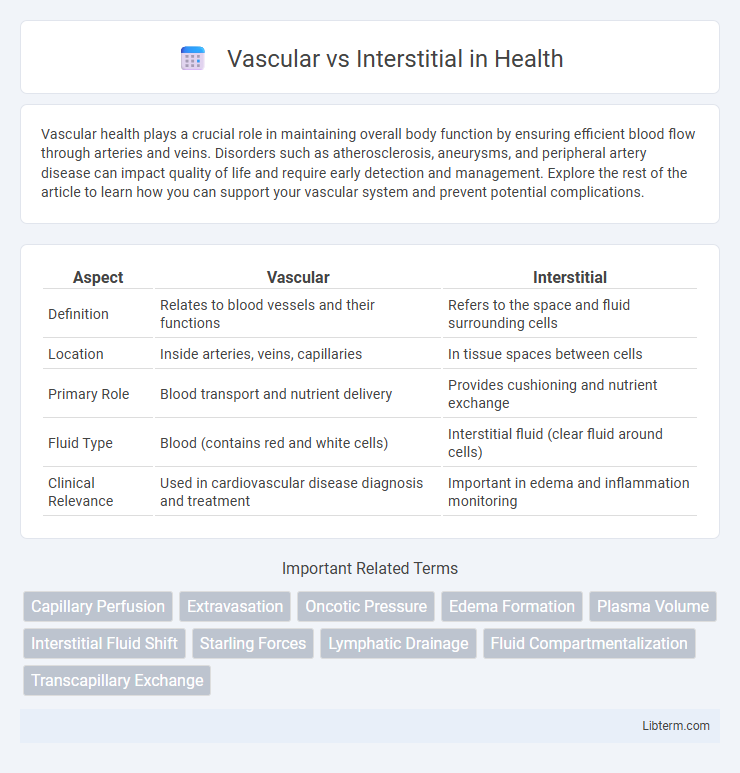Vascular health plays a crucial role in maintaining overall body function by ensuring efficient blood flow through arteries and veins. Disorders such as atherosclerosis, aneurysms, and peripheral artery disease can impact quality of life and require early detection and management. Explore the rest of the article to learn how you can support your vascular system and prevent potential complications.
Table of Comparison
| Aspect | Vascular | Interstitial |
|---|---|---|
| Definition | Relates to blood vessels and their functions | Refers to the space and fluid surrounding cells |
| Location | Inside arteries, veins, capillaries | In tissue spaces between cells |
| Primary Role | Blood transport and nutrient delivery | Provides cushioning and nutrient exchange |
| Fluid Type | Blood (contains red and white cells) | Interstitial fluid (clear fluid around cells) |
| Clinical Relevance | Used in cardiovascular disease diagnosis and treatment | Important in edema and inflammation monitoring |
Introduction to Vascular vs Interstitial Compartments
The vascular compartment consists of blood vessels that transport blood throughout the body, playing a critical role in delivering oxygen and nutrients to tissues. The interstitial compartment lies between the vascular system and cells, filled with interstitial fluid that facilitates exchange of substances between blood and cells. Understanding the dynamics between these compartments is essential for comprehending fluid balance and tissue homeostasis.
Understanding Vascular Spaces
Vascular spaces are channels within the circulatory system, including arteries, veins, and capillaries, that facilitate blood flow and nutrient transport throughout the body. Interstitial spaces, by contrast, are the microscopic gaps between cells and blood vessels where extracellular fluid accumulates, enabling nutrient exchange and waste removal at the cellular level. Understanding vascular spaces is essential for comprehending how blood circulates, delivers oxygen, and supports tissue metabolism in physiological and pathological conditions.
Defining Interstitial Tissue
Interstitial tissue refers to the space between blood vessels and cells, containing extracellular matrix and fluid that supports tissue structure and facilitates nutrient and waste exchange. Unlike vascular tissue, which comprises blood vessels responsible for transporting blood, interstitial tissue acts as a medium for cellular communication and biochemical signaling. Its composition includes fibroblasts, collagen fibers, and interstitial fluid, which maintain tissue hydration and provide mechanical support.
Key Differences Between Vascular and Interstitial Fluids
Vascular fluid primarily refers to blood plasma circulating within the blood vessels, delivering oxygen and nutrients while removing waste products from tissues. Interstitial fluid surrounds tissue cells, acting as an intermediary that facilitates the exchange of substances between blood and cells, maintaining a stable environment for cellular functions. Key differences include the composition, with vascular fluid containing higher protein levels and cells, whereas interstitial fluid is lower in proteins and lacks blood cells, and their locations, as vascular fluid is confined to the circulatory system while interstitial fluid fills the spaces between cells.
Functional Roles in Fluid Balance
Vascular compartments primarily manage fluid transport and distribution through blood vessels, maintaining blood pressure and nutrient delivery, while interstitial spaces regulate fluid exchange between cells and capillaries, facilitating nutrient uptake and waste removal. The endothelial barrier in vascular systems controls permeability, preventing excessive fluid loss, whereas interstitial matrices modulate osmotic gradients critical for fluid retention and movement. Disruptions in these functions can lead to edema or dehydration, highlighting their complementary roles in overall fluid balance.
Clinical Implications: Edema and Fluid Shifts
Vascular and interstitial compartments play crucial roles in regulating fluid balance, with vascular fluid shifts significantly impacting blood pressure and tissue perfusion, while interstitial fluid accumulation primarily causes edema. Disruptions in vascular permeability or lymphatic drainage can lead to excessive interstitial fluid, resulting in clinically significant edema, which may impair organ function and delay wound healing. Understanding the distinct mechanisms of vascular and interstitial fluid dynamics aids in targeted management of fluid overload, heart failure, and inflammatory conditions.
Vascular vs Interstitial in Disease States
Vascular and interstitial compartments differ significantly in disease states, influencing fluid distribution and pathology progression. In vascular disorders such as hypertension and atherosclerosis, endothelial dysfunction alters capillary permeability, promoting fluid leakage into the interstitial space and contributing to edema. Conversely, diseases primarily affecting the interstitial space, like fibrosis and lymphedema, disrupt interstitial fluid balance and extracellular matrix composition, impairing tissue oxygenation and nutrient exchange.
Diagnostic Approaches to Assess Fluid Compartments
Diagnostic approaches to assess vascular and interstitial fluid compartments primarily include bioelectrical impedance analysis (BIA), which estimates extracellular and intracellular fluid volume by measuring tissue resistance and reactance. Isotopic tracer dilution techniques, such as using labeled albumin or inulin, provide accurate quantification of plasma volume and interstitial fluid by tracking the distribution of injected markers. Imaging modalities like MRI and ultrasound further enhance the evaluation by visualizing fluid accumulation and compartmental shifts in diverse clinical conditions.
Management Strategies for Fluid Imbalances
Management strategies for vascular and interstitial fluid imbalances prioritize accurate assessment and targeted interventions. Vascular fluid imbalances often require careful monitoring of blood volume and administration of intravenous fluids or diuretics to restore hemodynamic stability. Interstitial fluid imbalances demand approaches such as compression therapy and mobilization techniques to reduce edema and promote lymphatic return.
Future Research in Vascular and Interstitial Dynamics
Future research in vascular and interstitial dynamics will emphasize the integration of advanced imaging techniques with molecular profiling to unravel the complex interactions between blood flow and tissue microenvironment. Developing computational models to simulate vascular remodeling and interstitial fluid transport promises to enhance targeted drug delivery and tissue engineering. Understanding the crosstalk between vascular endothelial cells and interstitial matrix components will drive innovations in treating chronic inflammation and cancer metastasis.
Vascular Infographic

 libterm.com
libterm.com